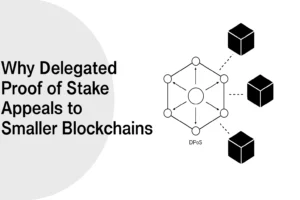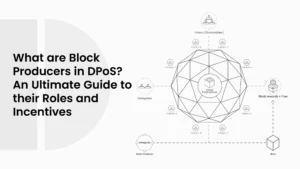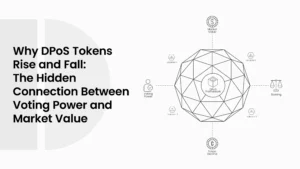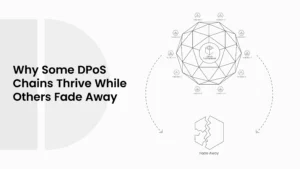Vouching for the Planet: Can Delegated Proof of Stake (DPoS) Handle Climate Data at Scale?
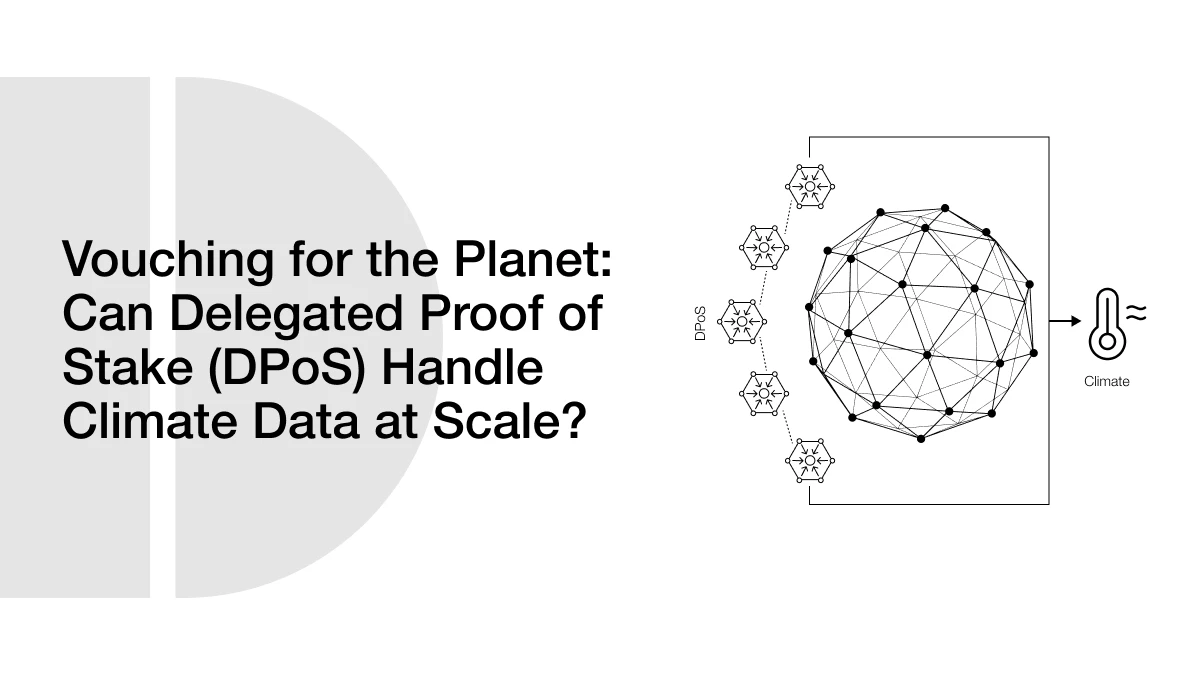
Climate data is one of the largest and most complex types of information in the world. It comes from satellites, ocean buoys, weather stations, and millions of Internet of Things (IoT) sensors. This data is used to track global warming, measure carbon emissions, and predict extreme weather events. Because climate data affects policy decisions and climate action plans, it must be stored, shared, and verified in a way that is fast, secure, and reliable.
- Understanding Delegated Proof of Stake (DPoS)
- Why DPoS Works Well for Big Data
- How DPoS Compares to Other Consensus Methods for Climate Data Needs
- Why Climate Data Needs a Scalable Blockchain Solution
- The Size and Complexity Problem
- The Need for Real-Time Monitoring
- Trust and Transparency
- Climate Data vs. Blockchain Capability Requirements
- Can DPoS Meet the Scale and Speed Requirements?
- How DPoS Handles High Transaction Volumes
- The Role of Delegated Validators
- Real-World DPoS Scalability Benchmarks
- Scalability Metrics – DPoS vs PoW vs PoS for Climate Data
- Energy Efficiency and Environmental Impact of DPoS
- Why Energy Use Matters For Climate Projects
- Learning From Ethereum’s Shift To Pos
- What This Means For DPoS
- Ensuring Security and Reliability for Climate Data
- Risks of Validator Centralization in DPoS
- How Reputation Systems Improve Trust
- Rotation and Backup Validators
- Security Case Study – High-Value Data
- Real-World Examples and Pilot Projects
- ClimateChain: Tracking Emissions in Real Time
- Ocean Health Monitoring
- IoT Sensors for Carbon Reporting
- Partnerships with Other Sustainable Tech
- Limitations of DPoS for Climate Data
- Potential Data Bottlenecks
- Validator Selection Bias
- Dependence on Off-Chain Storage
- Limited Real-World Testing for Climate Data
- Improving DPoS for Large-Scale Climate Applications
- Hybrid Consensus Models
- Integrating Zero-Knowledge Proofs (ZKPs)
- Optimizing Node Communication
- Better Off-Chain Data Linking
- Future Outlook
- Advances in Sustainable Consensus
- Integration with AI for Data Quality
- Global Climate Data Networks
- Role of Policy and Regulation
- Conclusion
- Frequently Asked Questions (FAQs)
- Glossary of Key Terms
Blockchain technology is a good match for this type of data since it generates a distributed log that cannot be altered without the consent of the network. However, traditional blockchain networks, particularly those based on Proof of Work (PoW), are far too slow and power-intensive to do this task. Enter Delegated Proof of Stake (DPoS). It is an alternative method of operating a blockchain that is fast, less expensive, and environmentally friendly.
This blog will explore whether DPoS can truly handle climate data at scale. Additionally, this blog will delve into the unique features of DPoS, the challenges posed by climate data, and the effectiveness of DPoS in terms of speed, scalability, and sustainability. This blog will also check its limitations, see where it’s already being used, and identify potential improvements to make it even better for climate applications.
This question matters because if blockchain is going to play a role in climate action, it must be able to handle massive data streams without harming the environment it’s trying to protect.
Understanding Delegated Proof of Stake (DPoS)
Delegated Proof of Stake, or DPoS, is a type of blockchain consensus system. A “consensus system” is simply the method the network uses to agree on what data is true and can be added to the chain. Every blockchain needs this agreement process so no one can fake or change information without the rest of the network knowing.
ALSO READ: How Stablecoins Strengthen Liquidity, Speed, and Stability in DPoS Networks
In DPoS, the decision-making power is given to a small group of trusted participants called validators. Through a voting process, the community selects these validators. People who own tokens in the network vote for the validators they trust the most. The chosen validators are then responsible for checking transactions, adding new blocks of data, and keeping the network secure.
This contrasts with Proof of Work (PoW), in which thousands of computers race to solve complex math problems to append blocks, and Proof of Stake (PoS), in which anybody with sufficient tokens can personally verify transactions. The heavy work in DPoS is only done by the elected validators; thus, it is significantly faster and considerably less energy-intensive.
Why DPoS Works Well for Big Data
Because there are fewer validators, blocks can be added to the chain very quickly. This means more transactions per second (TPS) and lower wait times for confirming new data. For climate data, which comes in constantly from many different sources, this speed is important.
Another benefit is lower hardware needs. Validators don’t have to run massive mining rigs like in PoW. This makes the system more energy-efficient, which is a big plus when the goal is to support climate action without adding a large carbon footprint (Pineda et al., 2024).
How DPoS Compares to Other Consensus Methods for Climate Data Needs
| Feature | Proof of Work (PoW) | Proof of Stake (PoS) | Delegated Proof of Stake (DPoS) |
| Energy Use per Transaction | Very High | Low | Very Low |
| Transactions per Second (TPS) | 7–15 | 1,000+ | 2,000–3,000+ |
| Hardware Requirements | Specialized Mining | Regular Servers | Regular Servers |
| Best Use Case | High Security | General Purpose | High-Speed, Large Data Streams |
| Carbon Footprint | High | Low | Very Low |
Why Climate Data Needs a Scalable Blockchain Solution
Climate data is not like data you would store in a spreadsheet or a website database. It is huge, unbroken, and has many different sources at the same time. Every second, satellites transmit data about temperature, sea levels, and air quality. Weather stations are used for recording rainfall, humidity, and wind speed. Ocean buoys monitor tides and currents. Even home and factory smart devices can measure energy consumption and carbon emissions.
All this results in massive information flows that require storage in a manner that can be trusted. In the event of a minor alteration or loss of any of this data, scientists and policymakers may make incorrect decisions regarding climate action.
The Size and Complexity Problem
Over time, climate data sets may be measured in petabytes (millions of gigabytes). As an example, a typical year of satellite images to track weather around the world could easily be hundreds of terabytes. This volume of data can be stored using traditional storage systems; however, they do not necessarily possess robust mechanisms for preventing tampering or manipulation.
Blockchain resolves this by producing an immutable history of the information. When climate information is stored, it cannot be edited secretly without being noticed by all the people in the network.
The Need for Real-Time Monitoring
Certain climate information, such as wildfire detection or flood alert, has to be collected and distributed in seconds. Slow systems may translate to delayed alerts and more damage. This is the reason why fast confirmation times, consensus methods of blockchain such as DPoS, are worth considering when it comes to climate applications.
Trust and Transparency
Climate data usually influences international policies and investments. The countries can decide to fund based on the reduction of emissions or the climate goals. To this end, information must be open and credible to everyone. A shared ledger using a public blockchain can assist here by ensuring that all view the same, verified numbers.
Climate Data vs. Blockchain Capability Requirements
| Requirement | Climate Data Needs | Blockchain Feature Needed |
| Data Size | Terabytes to Petabytes | Scalability & Off-chain Support |
| Update Speed | Seconds to Minutes | High TPS & Low Latency |
| Data Integrity | Must Be Tamper-Proof | Strong Consensus Mechanism |
| Transparency | Global Public Access | Public Ledger Capability |
| Environmental Responsibility | Low Carbon Footprint | Energy-Efficient Consensus |
Can DPoS Meet the Scale and Speed Requirements?
Delegated Proof of Stake is designed for speed and efficiency, and this is where it starts to stand out for climate data use. DPoS can confirm blocks in seconds as opposed to minutes in Proof of Work. This implies that the network can handle thousands of transactions per second, which is a necessity when you have to deal with large volumes of data from sensors, satellites, and monitoring stations all over the world.
ALSO READ: Data Processing with DPoS and Edge Computing: Blockchain’s Future Looks Bright
How DPoS Handles High Transaction Volumes
DPoS restricts the participants who can validate transactions at any one moment. Rather than thousands of miners trying to compete, there is a small number of elected validators that add new data to the blockchain. This smaller organization can communicate at a higher rate, decisions are made quicker, and transactions are confirmed within a fraction of the time.
For climate systems, this means that data from a rainfall sensor in Kenya and a satellite reading in the Arctic could both be recorded almost instantly and securely.
The Role of Delegated Validators
Since validators are elected, they also have a reputation to lose. In case they are dishonest or do a bad job, they can be substituted by the community. This increases their chances of processing transactions fast and equitably. In the case of global climate projects, the validators must be accountable to establish trust.
Real-World DPoS Scalability Benchmarks
Some of today’s DPoS-based blockchains, like EOS and Lisk, have shown they can handle 2,000–3,000+ transactions per second (TPS). This is far above what most environmental monitoring projects use now. While climate data blocks may be larger, the network’s throughput capability shows strong potential for scaling.
Scalability Metrics – DPoS vs PoW vs PoS for Climate Data
| Consensus Method | Avg. TPS | Block Confirmation Time | Suitability for Real-Time Climate Data |
| Proof of Work (PoW) | 7-15 | ~10 minutes | Poor – Too Slow |
| Proof of Stake (PoS) | 1,000+ | ~10–60 seconds | Good – Can Handle Most Climate Data |
| Delegated PoS (DPoS) | 2,000-3,000+ | ~1–3 seconds | Excellent – Real-Time Ready |
Energy Efficiency and Environmental Impact of DPoS
Talking about climate data, the blockchain that carries this data should not add more carbon to the atmosphere. This is where Delegated Proof of Stake (DPoS) looks strong. DPoS does not use heavy mining. It uses a small set of elected validators instead. This design cuts energy use significantly compared with Proof of Work. Reviews of sustainable consensus methods point out that PoS-family systems, including DPoS, generally have much lower energy demand and a smaller environmental footprint than PoW. That makes them better candidates for climate projects that care about credibility and emissions.
Why Energy Use Matters For Climate Projects
If a chain is used that burns too much electricity, it weakens the message of the project. Studies of PoW networks like Bitcoin show high electricity use and sizable annual CO₂ emissions, which is the opposite of what climate programs want. These studies helped push the industry toward more efficient models. (Stoll, Klaaßen, & Gallersdörfer, 2019).
Learning From Ethereum’s Shift To Pos
In 2022, Ethereum moved from PoW to PoS. Multiple independent summaries report a ~99.95% to ~99.99% drop in energy use after the change. That shows how big the gap is between mining and staking models. While Ethereum uses plain PoS (not DPoS), the efficiency lessons carry over because DPoS is a staking-based model too. (EU Blockchain Observatory & Forum, 2022).
What This Means For DPoS
Because DPoS relies on a small, elected validator set instead of thousands of miners, its power draw per transaction is very low. The MDPI review groups DPoS with other staking methods as more sustainable options compared with PoW, which aligns with what is seen in real networks. For climate data platforms, this makes DPoS a strong fit when you need both speed and a light carbon footprint.
| Criterion | Proof of Work (PoW) | Proof of Stake (PoS) | Delegated Proof of Stake (DPoS) |
| Mechanism | Competitive mining | Validators stake coins | Elected validators stake coins |
| Typical energy profile | Very high | Very low (post-Merge data shows ~99.95% cut vs PoW) | Very low (similar to PoS due to validator design) |
| Example data point | Bitcoin: large annual energy and CO₂ totals | Ethereum: ~99.95–99.99% energy drop after Merge | No global “one chain” metric; design implies PoS-like |
| Climate-program suitability | Weak, due to energy footprint | Strong | Strong |
Ensuring Security and Reliability for Climate Data
Security is more than just protecting a password. If someone were able to change or delete temperature records, sea level reports, or carbon emission readings, the result could be wrong scientific conclusions and misleading climate policies. That is why any blockchain used for climate data must be both secure and reliable.
Risks of Validator Centralization in DPoS
In DPoS, only a small group of validators has the power to approve and add data to the blockchain. This makes the system faster, but it also creates a risk: if a few validators act together in bad faith, they could manipulate the data. This is called centralization risk. For climate projects, where trust is critical, this risk must be managed carefully.
How Reputation Systems Improve Trust
Many DPoS networks use reputation scoring. This means that validators with a history of honest and efficient work are more likely to be reelected. If they cheat or perform poorly, they lose votes and are hence replaced. For a climate data system, such a reputation model can help ensure long-term integrity, since bad actors can be removed before they cause major harm.
Rotation and Backup Validators
Some DPoS systems rotate validators regularly or keep a list of backup validators. This rotation makes it harder for one group to stay in control for too long. It also reduces the chance of downtime, which is important for continuous data flow from climate monitoring devices.
Security Case Study – High-Value Data
There have been examples where DPoS-based blockchains have managed large-scale, high-value datasets without major breaches. While most of these examples come from finance and gaming sectors, the same principles apply to climate systems. Strong encryption, community voting, and fast dispute resolution can protect both the speed and accuracy of incoming data.
Real-World Examples and Pilot Projects
Though DPoS tends to be associated with cryptocurrency platforms, the same design features that make it appealing to such projects also make it appealing to climate data projects. A number of pilot programs and proposals demonstrate how the technology can be used to manage massive environmental data with high-speed, transparency, and low energy consumption.
ClimateChain: Tracking Emissions in Real Time
ClimateChain, a blockchain-based greenhouse gas monitoring system, is a pilot idea. In this model, IoT devices in factories, farms, and transport terminals transmit information about CO2 emissions to a DPoS blockchain. The small body of elected validators swiftly confirms the data, and the data is added to an immutable record that is publicly available. Such an arrangement implies that any government or organization can verify emissions data without the need to use one particular privately-managed database.
Ocean Health Monitoring
DPoS could be used to monitor the data of ocean buoys that monitor the temperature, salinity, and pollution levels. In this kind of system, the buoys transmit their updates every few minutes. The incoming reports are processed by the validators in a few seconds, giving the environmental teams the ability to view trends or identify issues, such as harmful algal blooms, nearly in real-time.
IoT Sensors for Carbon Reporting
The other potential application is the combination of DPoS and smart sensors in urban areas. These sensors include the air quality, energy consumption, and waste production. Information may pour in simultaneously on hundreds of devices. Since DPoS has been designed to work at high speed, it can confirm all these updates in a couple of seconds, and maintain the environmental dashboard up-to-date and accurate.
Partnerships with Other Sustainable Tech
In some cases, DPoS systems can be connected to renewable energy platforms or carbon credit trading systems. This allows verified climate data to influence green energy rewards or carbon offset transactions directly, all recorded transparently on the blockchain.
Limitations of DPoS for Climate Data
Although Delegated Proof of Stake is a great system with numerous benefits, it is not flawless. There are a couple of concerns that should be remembered when considering its application to large-scale climate monitoring. Such weaknesses do not imply that DPoS is not a good option, but it does imply that projects need to plan well to prevent the issues.
Potential Data Bottlenecks
While DPoS can handle thousands of transactions per second, climate data can be large, mainly when it includes satellite images or high-resolution sensor readings. If too much big data is sent directly to the blockchain, it could slow down the process or make storage costs high. In practice, most systems use off-chain storage for large files and keep only the verification hash on the blockchain. This helps, but it adds complexity to the design.
Validator Selection Bias
In DPoS, validators are chosen by token holders. If only a few big players hold most of the tokens, they might vote for themselves or a small group of allies. This could lead to centralization, where a handful of validators control the data approval process. For climate data, where global trust is important, such bias could create disputes or reduce confidence in the system.
Dependence on Off-Chain Storage
Because blockchains are not made to store massive datasets, most climate applications will store the actual files elsewhere (cloud, distributed storage systems like IPFS) and put only a digital fingerprint on the blockchain. While this works well in many cases, it also means the reliability of the whole system depends partly on the off-chain storage provider, not just the blockchain itself.
Limited Real-World Testing for Climate Data
Most DPoS projects so far have been in finance, gaming, and social media, not in global environmental monitoring. That means there’s still little field data on how DPoS will perform under the unique challenges of climate science, like constant sensor updates from remote areas with poor internet connections.
Improving DPoS for Large-Scale Climate Applications
Delegated Proof of Stake already offers speed and efficiency, but for handling global climate data, it can be made even better. These improvements focus on solving bottlenecks, increasing trust, and making the system ready for continuous, heavy data loads from all over the world.
Hybrid Consensus Models
One way to make DPoS stronger is to combine it with other consensus types. For example, a hybrid of DPoS and Proof of Authority (PoA) could keep the speed of DPoS while adding stricter identity checks for validators. This can help reduce the risk of dishonest behavior while still keeping the network fast.
Integrating Zero-Knowledge Proofs (ZKPs)
Zero-Knowledge Proofs (ZKPs) are cryptographic methods that let someone prove information is true without revealing all the details. In climate monitoring, this could allow validators to confirm that data is valid without exposing sensitive locations or proprietary sensor details.
Optimizing Node Communication
Many climate sensors work in remote areas with weak internet. By improving how validator nodes communicate, for example, using regional hubs or satellite-based links, the system could process data faster and more reliably, even in remote areas such as the middle of the ocean or the polar regions.
ALSO READ: Can Delegated Proof of Stake (DPoS) Transform National Voting Systems Worldwide?
Better Off-Chain Data Linking
Since most climate files will be stored off-chain, using stronger linking systems like permanent hash chains or multi-redundant storage networks will make it harder for off-chain data to be lost or tampered with.
| Improvement Area | Example Solution | Benefit for Climate Data |
| Hybrid Consensus | DPoS + PoA | Faster validation + stronger identity checks for validators |
| Data Privacy | Zero-Knowledge Proofs | Validates data without revealing sensitive information |
| Connectivity | Regional validator hubs | Reduces delays from remote sensor uploads |
| Off-Chain Storage Security | Redundant distributed storage (e.g., IPFS) | Prevents data loss and ensures long-term reliability |
Future Outlook
The future of climate data management will depend on systems that can process huge volumes of information quickly, securely, and with minimal environmental impact. Delegated Proof of Stake already meets many of these needs, but the technology will likely improve even further in the next few years.
Advances in Sustainable Consensus
Recent studies on sustainable blockchain design (Pineda et al., 2024) suggest that next-generation DPoS algorithms could integrate dynamic validator sets that adjust automatically based on network load. This means the system could use more validators during peak climate events like hurricanes or heatwaves and fewer during quieter periods, keeping energy use balanced.
Integration with AI for Data Quality
Artificial intelligence can help detect unusual patterns or errors in incoming data. When combined with DPoS, AI tools could flag false readings before they are added to the blockchain. For example, if a faulty sensor reports impossible wind speeds, AI could warn validators before final approval.
Global Climate Data Networks
In the long term, multiple DPoS-based climate blockchains could be connected into a global interoperability layer. This would allow environmental agencies, research institutions, and governments to share verified data instantly, regardless of the blockchain platform used.
Role of Policy and Regulation
As governments and NGOs increase climate reporting requirements, blockchain systems like DPoS may see more adoption. However, rules will be needed to ensure validator transparency, ethical data use, and protection of sensitive environmental locations. Clear standards also make it easier for climate projects to get funding from international organizations.
Conclusion
Climate data management demands speed, trust, and sustainability, three areas where Delegated Proof of Stake excels. By using elected delegates instead of energy-hungry mining, DPoS keeps energy use low while maintaining high transaction throughput.
When paired with AI, IoT sensors, and global data-sharing frameworks, DPoS can help ensure climate information is accurate, transparent, and accessible. This combination of efficiency, scalability, and security could make DPoS one of the most important tools in the fight against climate change.
Frequently Asked Questions (FAQs)
- Why is blockchain important for climate data management?
Blockchain ensures that climate data is transparent, tamper-proof, and easily shareable among multiple organizations without a central authority. - How does DPoS reduce environmental impact compared to Proof of Work?
DPoS uses a small group of elected validators instead of thousands of miners, cutting energy consumption dramatically. - Can DPoS handle large-scale climate data from around the world?
Yes. Its high transaction speed and scalability make it ideal for processing global climate sensor data in real time. - What risks does DPoS face in climate data projects?
Risks include delegate collusion, governance issues, and the need for strict validator transparency to maintain trust. - How could AI improve blockchain-based climate systems?
AI can detect errors, anomalies, and patterns in climate data before they are permanently stored, improving accuracy.
Glossary of Key Terms
Blockchain – A decentralized digital ledger where data is recorded in blocks linked together chronologically.
Delegated Proof of Stake (DPoS) – A blockchain consensus system where token holders elect a small number of trusted validators to approve transactions.
Validator – A network participant responsible for confirming transactions and maintaining blockchain integrity.
IoT Sensors – Internet-connected devices that collect and transmit real-world data, such as temperature, rainfall, or air quality.
Interoperability – The ability of different blockchain systems to exchange and use information seamlessly.
Dynamic Validator Set – A flexible group of validators that can change size depending on network demands.

